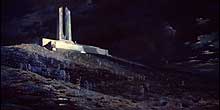
|
|

|
|

|
||||||
 |
BRINGING CANADIANS AND COMMITTEES CLOSER TOGETHER Committee Work
Together for
Canadians
|

|
PHOTO: © HOUSE OF COMMONS |
Bringing
Canadians and Committees Closer Together
Technology and process improvements can bring many
advantages to the complex and time-consuming task of
committee work. The House of Commons made two
developments recently to enable Canadians to
participate more actively in the work of committees: a
pilot project was conducted to improve the public's
electronic access to committee evidence; and as part of
a renewed
committee Web site work continued to create
e-consultation tools that will allow committees to use
the Internet to consult with Canadians.


|
|
The House of Commons is the custodian of an important collection of art and artifacts reflecting Canada's social and political history. Many of these works are displayed throughout Parliament, including its committee rooms. This painting, Ghosts of Vimy Ridge, is currently on loan to the new Canadian War Museum, but its permanent home is the Centre Block's historic Railway Committee Room. Portraying the flickering spirits of departed Canadian soldiers making their way toward the summit of the ridge, it was painted in 1929 by Australian artist William Longstaff and purchased by Captain John Dewar, who donated it to Parliament in 1931. |
|
![]()
![]()
Standing Committees
Standing committees are permanent committees
mandated to oversee activities of government
departments or to exercise procedural and
administrative responsibilities related to Parliament.
Special Committees
Special committees are appointed by the House of
Commons to inquire into specific matters. They exist
only until they reach their deadline or issue a final
report, or until the end of the session.
Legislative
Committees
Legislative committees examine and inquire into
specific bills referred to them by the House of
Commons, and report the same bills with or without
amendments.
Joint Committees
Joint committees consist of Members of Parliament
and Senators. Members sit on two standing joint
committees: the Standing Joint Committee on the
Scrutiny of Regulations and the Standing Joint
Committee on the Library of Parliament.
Subcommittees
Standing committees may delegate any or all of their
powers to a
subcommittee, except the power to report directly
to the House of Commons. Special committees may only
form subcommittees if so ordered by the House of
Commons. Legislative committees may form only one
subcommittee, the Subcommittee on Agenda and
Procedure.
For more information on Members' committee
activities, visit the Parliament of Canada Web
site.
![]()
- Aboriginal Affairs and Northern Development
- Access to Information, Privacy and Ethics
- Agriculture and Agri-Food
- Canadian Heritage
- Citizenship and Immigration
- Environment and Sustainable Development
- Finance
- Fisheries and Oceans
- Foreign Affairs and International Trade
- Government Operations and Estimates
- Health
- Human Resources, Skills Development, Social Development and the Status of Persons with Disabilities
- Industry, Natural Resources, Science and Technology
- Justice, Human Rights, Public Safety and Emergency Preparedness
- National Defence and Veterans Affairs
- Official Languages
- Procedure and House Affairs
- Public Accounts
- Status of Women
- Transport
![]()